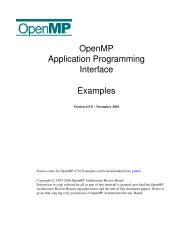D2 3 Computing e-Infrastructure cost calculations and business _models_vam1-final
D2 3 Computing e-Infrastructure cost calculations and business _models_vam1-final
D2 3 Computing e-Infrastructure cost calculations and business _models_vam1-final
Create successful ePaper yourself
Turn your PDF publications into a flip-book with our unique Google optimized e-Paper software.
e-‐FISCAL: www.efiscal.eu <br />
EC Contract Number: 283449 <br />
• At approx. 15% utilisation rate or more compared to on dem<strong>and</strong> instances. <br />
• At approx. 20% utilisation rate or more compared to 1-‐year reserved instances utilised at 60% or 80%. <br />
The <strong>cost</strong> per core hour of e-‐FISCAL average becomes less expensive when the e-‐infrastructure operates: <br />
• At approx. 25% utilisation rate or more compared to on dem<strong>and</strong> instances. <br />
• At approx.30% utilisation rate or more compared to 1-‐year reserved instances utilised at 60%. <br />
• At approx. 40% utilisation rate or more compared to 1-‐year reserved instances utilised at 80%. <br />
It should be noted that the average <strong>and</strong> median utilisation rate for 2011 of e-‐FISCAL sample was 65% <strong>and</strong> 75% <br />
respectively. <br />
4.5 Research question 4: Business <strong>models</strong><br />
This section is devoted to investigate possible scenarios for <strong>business</strong> <strong>models</strong> that envision a combined usage of <br />
public-‐funded federated infrastructures with commercial cloud providers. Furthermore, it will derive pricing <br />
<strong>models</strong> characteristics being used for cloud services so as to organize concepts <strong>and</strong> support e-‐<strong>Infrastructure</strong> <br />
managers in defining possible pricing schemes for their services. <br />
4.5.1 Integration of e-<strong>Infrastructure</strong>s with commercial cloud providers<br />
As mentioned, commercial cloud services are becoming appealing for the research sector, especially in low-‐end <br />
computing. Additional added benefits include access to different types of resources/features or service levels <strong>and</strong> <br />
more elasticity. The role of Cloud Service Brokers (CSB) is emerging in different sectors, which is also being <br />
highlighted in Europe through the Helix Nebula project (http://www.helix-‐nebula.eu/) <strong>and</strong> the EGI Federated <br />
Cloud (http://www.egi.eu/infrastructure/cloud/). These initiatives are answering questions <strong>and</strong> putting into <br />
practice a number of cloud services dedicated for researchers while showing how federated infrastructures can <br />
work alongside <strong>and</strong>/or integrate with commercial providers. This can be shown through a number of scenarios <br />
that we will develop in this section. All scenarios consider that academic users relying on a publicly funded <br />
federated infrastructure with needs to exp<strong>and</strong> the resource usage to commercial providers. The first scenario <br />
(Figure 10) envisions a peering between the public funded infrastructure broker with an external broker service <br />
that aggregates commercial cloud providers (e.g., as being designed by the Helix Nebula Initiative). <br />
e-‐FISCAL : Financial Study for Sustainable <strong>Computing</strong> e-‐<strong>Infrastructure</strong>s <br />
Deliverable <strong>D2</strong>.3 – <strong>Computing</strong> e-‐<strong>Infrastructure</strong>s <strong>cost</strong> estimation <strong>and</strong> analysis – Pricing <strong>and</strong> <br />
Business <strong>models</strong> <br />
63




